Android Move Asset
The Move Asset function is used to move an asset from one location/group to another location/group.
Note: Make sure to enable the Capture Transaction Geolocation under settings to capture the Geolocation of the transaction operation.
Note: Group Widget in the Asset Tag field - The Group Widget is a dropdown button that will appear for the asset that has "Transact As Whole" feature enabled. The Group Widget in the transaction page supports the behavior of Group on a Transaction screens. It always ‘remembers’ the Asset that was selected as well as the group(s) that the asset is in.
Steps to Move Asset
- Tap on the Transactions > Move.
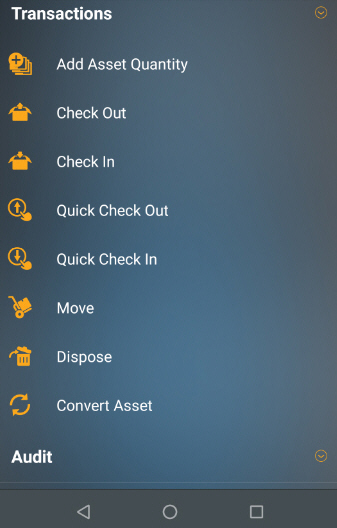
-
The Move screen will appear.
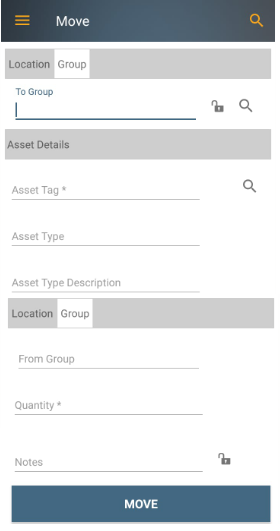
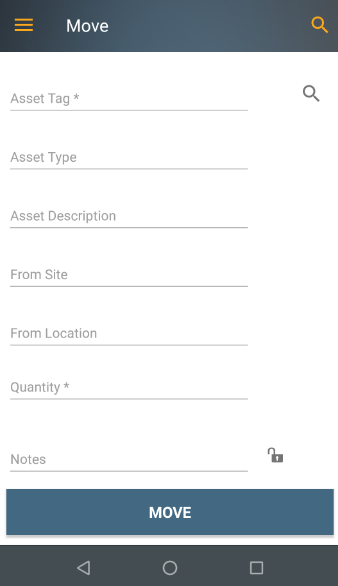
Note:
- If the Capture Transaction Geolocation under settings is enabled, then a pop-up message will appear asking the user to allow the application to access the device's location. Click on the Deny or Allow button.
- If you click on the Allow button, the application will enable the device's location and then this pop-up message will not appear again throughout the transaction operation.
- If you click on the Deny button, then the pop-up message will again appear when you click on the Move button.
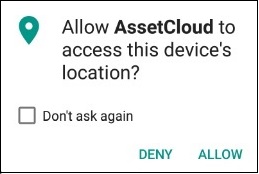
- Fields that are followed by an asterisk (*) are mandatory. Also, you can lock the field, refer Android Pinning Data topic.
- The Magnifying Glass icon at the top of the screen navigates to the Search Asset Tags screen. The Magnifying Glass icon next to a particular field will navigate to the Search screen of that particular field. For example, the Magnifying Glass icon next to a location field will navigate to the search location screen.
- You can use the keyboard to enter the information in any field. Or If you want to scan a barcode, use the Barcode scanner. Tap on the Barcode symbol, the scanner will appear. Scan the barcode and the field will display the scanned barcode number. For Asset Tags, you can use the RFID feature. Refer to Radio-frequency identification (RFID) topic for more information.
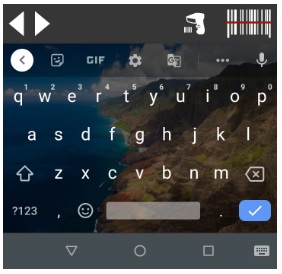
- To Location Tab or To Group Tab
Location Tab
- Enter the To Site. The Site can be added by clicking on the search button next to the field. Click on the search button, the screen will navigate to the Search Sites screen where you can search and add the Site.
- Enter the To Location. The location can be added by clicking on the search button next to the field. Click on the search button, the screen will navigate to Search Location screen where you can search and add the location. You can also add a new location by clicking on the '+' symbol on the Search Locations screen. Refer New Location.
Group Tab
- Enter the To Group. The Group can be added by clicking on the search button next to the field. Click on the search button, the screen will navigate to Search Group Assets screen where you can search and add the Group.
Asset Details
- Enter the Asset Tag or search for the asset in the search asset screen that you want to move. The Asset tag can be a fixed asset, multi-quantity asset or a Group/Asset in a Group.
- If the selected 'Asset' is in a group i.e. a child asset and "Transact as Whole" feature is enabled for the Group
- The asset tag field will automatically select the group (i.e. the parent) containing this asset. The Group Widget (dropdown button) will appear in the asset tag field and it will display the parent and the child asset. The View Group button will display all the grouped assets. Note that you can also select the child asset using the group widget. Example: Consider that HP Charger is a child asset for HP Laptop and Transact as Whole is enabled for HP Laptop. On selecting HP Charger, the asset tag will automatically select HP Laptop. Using the group widget, you can also select HP Charger.
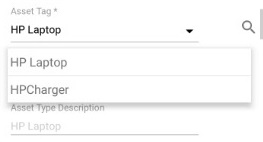
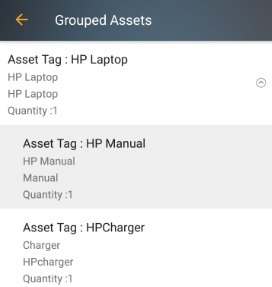
- If the selected 'Asset' is in a group i.e. a child asset and "Transact as Whole" feature is disabled for the Group
- The asset tag field will display the selected asset. The Group Tag field under Group tab will display the group name (i.e. the parent asset). Example - Consider that Flip Case is a child asset of Mobile. If you select Flip Case, since Transact As Whole is disabled for the Group (i.e. Mobile) containing Flip Case, the Asset Tag will display Flip Case and From Group will display Mobile.
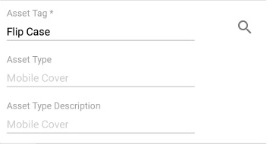
- If the selected asset is a 'Group (parent asset)' and "Transact as Whole" feature is enabled for a group
- The asset tag field will select the whole group i.e. all the sub-items will be moved by default. The View Group button will display the grouped assets.
Example: Consider that there are 3 groups - Container 1, Container 2, Container 3. Container 1 and Container 2 are Transact as whole.
If you select Container 1, the parent group i.e. Container 2 with transact as whole feature enabled will get selected. Note that you can also select Container 1 using the group widget.
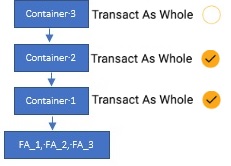
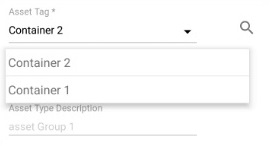
- If the selected asset is a 'Group (parent asset)' and "Transact as Whole" feature is disabled for a group
- The asset tag field will select the whole group. The View Group button will display the grouped assets.
Example: Consider that there are 3 groups - Container 1, Container 2, Container 3. Container 1 and Container 2 are Transact as whole. Container 3 is not transact as whole. So on selecting container 3, whole group gets selected. You can also select Container 3 with no sub-items. The View Group button will display the grouped assets.
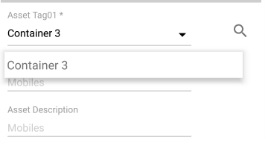
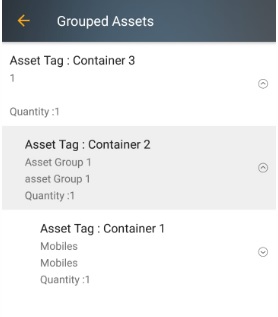
- From Location Tab or From Group Tab
Location Tab
- Enter the From Site. The Site can be added by clicking on the search button next to the field. Click on the search button, the screen will navigate to the Search Sites screen where you can search and add the Site.
- Enter the From Location. The location can be added by clicking on the search button next to the field. Click on the search button, the screen will navigate to the Search Location screen where you can search and add the location. You can also add a new location.
Group Tab
- Enter the From Group. The Group can be added by clicking on the search button next to the field. Click on the search button, the screen will navigate to the Search Group Assets screen where you can search and add the Group.
- Enter the Quantity to be moved. This will appear for multi-quantity asset.
Note - On choosing Fixed Asset - Asset Tag - Asset Type, Asset Description, From Site, From Location, Quantity will appear automatically.
- Enter Notes if any.
Custom Fields
- Fill all the Custom Fields.
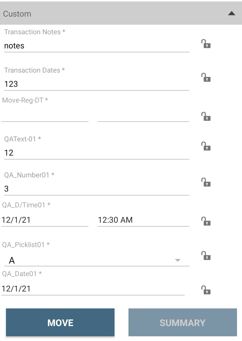
- Tap on the Move button.
Note: If the location permission is still disabled for the application, then a pop-up message will appear again asking the user to allow the application to access the device's location. Click on the Deny or Allow button. Once you click on the Allow button, the application will enable the device's location and then this pop-up message will not appear again throughout the transaction operation. But If you click on the Deny button, then the Geolocation will not get captured for this Move transaction.
If the selected asset is already at the chosen location, a message will appear asking for confirmation. Tap on Yes or No based on the requirement. Update the location, if you selected No option and tap on the Move button again.

- All the assets added for the move transaction will appear in the Summary screen.
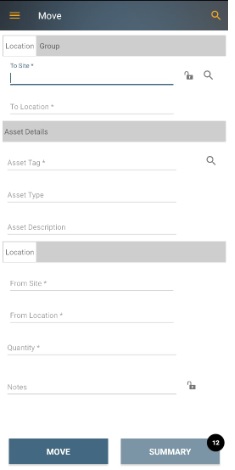
- Click on the Summary. The summary screen will appear. The summary screen will have details of each asset that you want to move. By default, all the assets will be checked. You can uncheck the assets that you do not want to move.
- Signature - The signature checkbox allows you to capture the signature. Click on the checkbox.
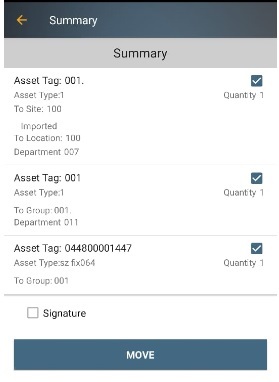
- Tap on the Move button.
- The Signature screen will appear, if the signature checkbox is checked. Sign and save the signature. Use Reset to sign again and Dismiss to navigate to the Summary screen.

Note: The move transaction and the signature can be viewed in the Reports > Transaction Reports > Transaction Move Reports > Select the Report Parameters > Run Report.



















